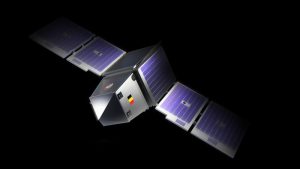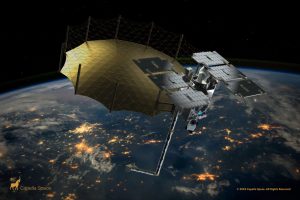The contract from the defence agency will see Redwire become the prime mission integrator for the development of an “air-breathing satellite” that will demonstrate the use of novel electric propulsion systems. This will be in VLEO, which is supported by the company’s SabreSat, pictured above (note that it recently created an equivalent Phantom platform, pictured below right, for the ESA’s VLEO Skimsat mission).
 Specifically, the programme will include experiments to explore “self-neutralized air breathing plasma”, this will be investigated as a medium to enable “novel electronic propulsion techniques”. They would use air from the atmosphere as the ionization medium.
Specifically, the programme will include experiments to explore “self-neutralized air breathing plasma”, this will be investigated as a medium to enable “novel electronic propulsion techniques”. They would use air from the atmosphere as the ionization medium.
SabreSat
As part of the contract, the space infrastructure company will be responsible for building its SabreSat bus and integrating, coordinating, and leading the project. The modular SabreSat “orbital drone” can include high-resolution intelligence, surveillance and reconnaissance (ISR) as well as Earth science payloads.
Redwire also said it would be using its proprietary Digitally Engineered Mission Systems & Integration (DEMSI) platform. This uses physics and thermosphere models that account for space weather to model atmospheric drag and material degradation caused by atomic oxygen.
“We are proud to be leveraging our SabreSat satellite design to support critical VLEO technology advancements for DARPA’s game-changing Otter program,” said Spence Wise, Redwire Senior VP for Missions and Platforms.
“As VLEO emerges as a critical domain for national security missions, Redwire is continuing to make investments to support technology innovation and strategic operations in this environment.”
VLEO
Redwire highlights the strategic significance of VLEO for Earth science, intelligence, communications, and defense and security applications. While low Earth (LEO) and geosynchronous (GEO) orbits are becoming increasingly congested and contested, spacecraft in VLEO operate in a relatively unimpaired environment, it says.
VLEO spacecraft bridge the gap between air and space – from 90 to 350 kilometers. Flying above airborne anti-access areas while operating closer to the Area of Responsibility on the ground than existing satellites, highlighted the company. Additionally, unlike LEO and GEO, debris in VLEO deorbits in hours or days rather than in decades or more.
Also, when collisions occur or antisatellite weapons strike targets in traditional low-Earth orbits, VLEO satellites are not affected.
See also: Redwire handed robotic arm prototype for the Argonaut lunar lander
 Electronics Weekly Electronics Design & Components Tech News
Electronics Weekly Electronics Design & Components Tech News




